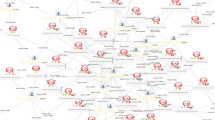Abstract
The graph data modeling is the most convenient process to work with in order to answer almost all questions that came across our minds when it comes to covid-19 infection (when was I infected? where? and who gave it me ?). Most of us wonder when we enter a closed space if we are going to face someone who tested positive, but is there any way to predict that? Luckily yes! This could be done by streaming contact data of citizens to a server that looks for any contacts between infected people and non infected ones and sends back a notification for the purpose. The collection, management and exploitation of data in the field of health continues to require the attention of researchers in relation to confidentiality, security, privacy and protection of personal data. Research is active in this area and we are willing to use simulation technologies in order to anticipate the contamination area and predict the propagation due to lack of shared data for reasons listed above. These data flows also constitute a considerable input for the extraction of knowledge and the application of artificial intelligence algorithms and more precisely of machine learning to predict and prevent the evolution of the epidemic on the affected persons as well as its geographical spread, after correlating sensitive data securely from all users, the initial objective is to model the system in the form of a graph and apply graph flow algorithms to predict the propagation network and notify the users if contaminated.
Supported by Military Research Center.
Access this chapter
Tax calculation will be finalised at checkout
Purchases are for personal use only
Similar content being viewed by others
References
Coronavirus Cases. Worldometer (2022). https://www.worldometers.info/coronavirus/
Soldano, G., et al.: On the effectiveness of digital contact tracing and contact prevention under varying COVID-19 infection detection rates . SSRN Electr. J. (2020). https://doi.org/10.2139/ssrn.3745828
Lee, Y.H., et al.: BLE beacon-based indoor distance measurement technique using outlier adjustment. J. Digit. Cont. Soc. 22(5), 839–45 (2021). https://doi.org/10.9728/dcs.2021.22.5.839
Angles, R., Gutierrez, C.: Survey of graph database models. ACM Comput. Surv. 40(1), 1–39 (2008). https://doi.org/10.1145/1322432.1322433
D’Eon, S.P.: Accuracy and signal reception of a hand-held global positioning system (GPS) receiver. For. Chron. 71(2), 192–196 (1995). https://doi.org/10.5558/tfc71192-2
Luoh, L.: Zigbee-based intelligent indoor positioning system soft computing Soft Comput.18(3), 443–456 (2013). https://doi.org/10.1007/s00500-013-1067-x View PDF Google Scholar
Design of three-dimensional traction substation simulation system based on unity3D. J. Electr. Eng. 07(02), 124–129 (2019). https://doi.org/10.12677/jee.2019.72015
Liao, L., Lin, K., Wang, X., Lai, X., Vuong, S.T.: WiFi positioning overview. Int. J. Commun. Netw. Distrib. Syst. 7(3/4), 229 (2011). https://doi.org/10.1504/ijcnds.2011.042377
Brewer, D.: Tactical Pathfinding on a NavMesh — Daniel Brewer — Taylor Francis G. Taylor Francis. https://www.taylorfrancis.com/chapters/edit/https://doi.org/10.1201/9780429054969- 2/tactical-pathfinding-navmesh-daniel-brewer, 6 septembre 2019
https://www.inserm.fr/information-en-sante/dossiers- information/coronavirus-sars-cov-et-mers-cov
Crestani, F.: Application of spreading activation techniques in information retrieval. Artif. Intell. Rev. 11(6), 453-482 (1997)
Babych, T., Gorokhovskyi, S.: Building and storing in graph database neo4j abstract symantic graph of PHP applications source code. NaUKMA research papers. Comput. Sci. 3(0), 27–30 (2020). https://doi.org/10.18523/2617-3808.2020.3.27-30
Rao, B.: An approach to represent social graph as multi-layer graph using graph mining techniques. Int. J. Educ. Manag. Eng. 9(1), 20–36 (2019). https://doi.org/10.5815/ijeme.2019.01.03
Ji, F., Deyong, W.: Design and implementation of 3- D terrain generation module in game. In: 2010 3rd International Conference on Advanced Computer Theory and Engineering (ICACTE) (2010), vol. 1, pp. 1-36 (2010). https://doi.org/10.1109/icacte.2010.5579067
Lin, Q., Son, J.: Analysis of bluetooth RSSI for proximity detection of ship passengers. Appl. Sci. 12(1), 517 (2022). https://doi.org/10.3390/app12010517
Acknowledgements
The research leading to these results were in the context of cooperation between Tunisian Military Research Center and Euranova. (Euranova is a consulting firm with a private research center dedicated to data science and AI. Its mission is to promote a data-centric culture and help large companies and start-ups at every stage of their digital transformation. https://euranova.eu/.)
Author information
Authors and Affiliations
Corresponding author
Editor information
Editors and Affiliations
Rights and permissions
Copyright information
© 2022 The Author(s), under exclusive license to Springer Nature Switzerland AG
About this paper
Cite this paper
Ahmed, B., Sami, N. (2022). Simulation System for Producing Real World Dataset to Predict the Covid-19 Contamination Process⋆. In: Nguyen, N.T., Manolopoulos, Y., Chbeir, R., Kozierkiewicz, A., Trawiński, B. (eds) Computational Collective Intelligence. ICCCI 2022. Lecture Notes in Computer Science(), vol 13501. Springer, Cham. https://doi.org/10.1007/978-3-031-16014-1_22
Download citation
DOI: https://doi.org/10.1007/978-3-031-16014-1_22
Published:
Publisher Name: Springer, Cham
Print ISBN: 978-3-031-16013-4
Online ISBN: 978-3-031-16014-1
eBook Packages: Computer ScienceComputer Science (R0)




